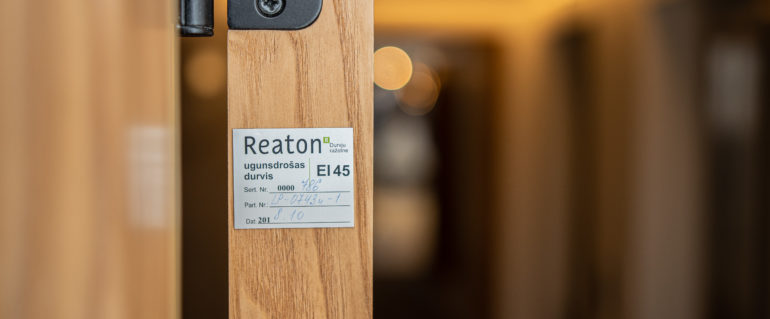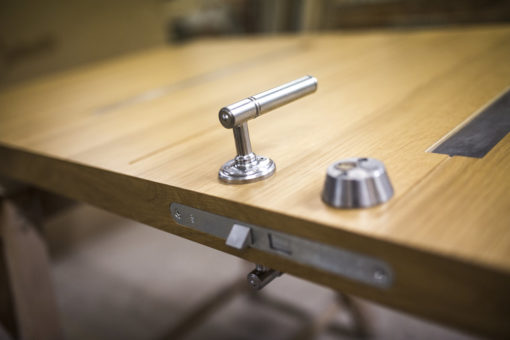
Door manufacturer’s warranty
The warranty covers the replacement and repairs of doors with defects, or of inadequate quality. The warranty is only valid if all of the manufacturer’s regulations for transportation, storage and operation are complied with.
- The manufacturer guarantees that the door (both the leaf and the frame), its finish and glazing are not defective, and provides a warranty effective for two years after the production of the door.
- The manufacturer’s warranty is only provided to direct buyers, i.e. end consumers or property owners, on whose premises the door is installed.
- The warranty does not cover defects (damage) caused:
- by acids or other chemicals, including water and steam,
- by high temperature or fire,
- by incorrect transportation and storage of the door,
- by incorrect assembly and installation of the door,
- by incorrect door operation and care,
- allowing other actions that violate the rules for transport, storage, assembly, installation, operation and care of the doors.
- The manufacturer undertakes to review all complaints that include the following information:
- description (type) of the door,
- door owner’s name, surname, address,
- the company or private individual that installed the door, and the installation date,
- proof of purchase (receipt),
- detailed description of the defects found.
The manufacturer reserves the right to postpone the replacement of deformed doors by 12 months (after the installation of the doors), taking into account the time necessary for the door material to stabilise in the given ambient temperature and humidity conditions.
DOOR FURNITURE WARRANTY AND MATERIAL COMPLIANCE
Door handles and accessories, window handles and their accessories.
Warranty is only provided for window and door handles and their accessories, if the following prerequisites are met:
- selection of products appropriate for the function, operating load and conditions of the doors,
- professional installation in compliance with instructions by the manufacturer and distributor,
- appropriate use and correct care for the material.
One must always keep in mind that the provisions of product warranty required by law and the consumer’s subjective opinions about the functions and quality of the product tend to differ. Door and window handles are only tools, intended to open and close doors and windows. The warranty does not apply if they are used for anything else. All door and window furniture is also unavoidably subject to wear.
Key prerequisites for obtaining a warranty:
- Door handles and accessories.
The function of a door handle is opening and closing the door. The door handle is only one part of the entire door set, which includes the door frame and leaf, the hinges, the lock and the lock cylinder. All these elements must be compatible with each other. For example, you must only be able to open or close the door with the door handle if the lock is unlocked. However, in certain cases—such as in emergency exit doors—handles also unlock their doors.
- Pull handles.
Pull handles, toomust match the frame and the leaf of the door, its hinges and other elements used to open or close it, e.g. the door closer. It is particularly important to observe the safety distance between the edge of the door and the handle’s fastening element set by the manufacturer.
Incorrect use
Window and door handles, pull handles are often used in a way that does not match their function, sooner or later resulting in various damage, or loss of product features defined by the manufacturer. Typical mistakes made by users:
- door handles used for support, or to pull your body towards the door, e.g. on doors that are at the top of a step;
- children ride on doors by holding onto the door handles;
- door handles and pull handles used instead of the missing door stoppers;
- door handles and pull handles used to hang heavy objects;
- door handles with emergency locks are used for everyday purposes, and not in emergencies only, against the recommendations of lock and door furniture manufacturers.
Product care.
Most of the furniture used with doors and windows is for opening or closing the doors and the windows. Their wear unavoidably depends on whether their material is appropriate for their intended use. Take a look at the properties of the following materials to get a better idea of what to choose:
- AluminiumAs a material for door furniture, aluminium has enjoyed decades of everyday use. It is protected with an eloxal finish, but harder materials can damage aluminium. A typical example of this is the traces left on door handles by rings that people wear. Scratches do worsen the look of aluminium furniture somewhat, but they never affect its functional features. This only indicates the ageing of the material. This feature of aluminium must be taken into account when choosing furniture for doors that see much everyday use. Aluminium does not require any special care. Stains can be easily removed with water and a soft cloth.
- Stainless steelThere is a common view that stainless steel does not wear out as a material. Its surface has maximum protection against rust, the material is hard to damage mechanically, it doesn’t get scratched, and thanks to the addition of chrome and nickel, it is very easy to maintain. Because of all this, stainless steel door furniture is particularly suited for doors that see much everyday use, such as those installed in public buildings, official institutions, hospitals, sports facilities. On rare occasions stainless steel surfaces can also get traces of scratches and spots of rust. The latter can be referred to as ‘air rust’, because the rust comes not from the material itself, but from its environment (e.g. in an unventilated indoor swimming pool). These spots can be removed with common cleaning agents and a lot of rubbing. Stainless steel does not require any special care in normal conditions. Stains can be easily removed with water and a soft cloth.
- BrassAs a material, brass is more sensitive and demanding than aluminium and stainless steel. While you could consider aluminium to be a more or less pure material, brass is a typical alloy whose components are susceptible to rust. This is why when choosing door furniture, you should keep in mind that long term, only unvarnished brass elements will remain aesthetically pleasing, given regular and correct care. Varnished brass furniture gets unsightly corrosion in the locations where the varnish is damaged, and this can only be corrected through a technically complicated process to remove the varnish. Regular polishing is the main way to care for unvarnished brass. Waxed brass furniture serves as alternative here, as it polishes itself with use. However, any surfaces that are not used every day, quickly gain a brown or greenish-grey patina.In conditions that promote corrosion (e.g. near the sea), we recommend replacing brass with stainless-steel furniture with brass-colour titanium coating. The hardness of the base material guarantees the resistance of the brass-coloured layer of titanium against the natural elements. If nevertheless you prefer brass, we recommend that you:— choose waxed brass furniture that can be cared for with normal cleaning agents;— do not use varnished brass furniture outdoors, where sunlight and unstable weather promote rust;— avoid using brass furniture on doors that see much use, unless much attention is paid to polishing the surface.
- BronzeLike brass, bronze is not a natural material, and it was invented literally ages ago. Bronze is an alloy of copper and tin. Thanks to the inclusion of tin, the relatively soft copper becomes very hard and durable. Manufacturers of door handles use the CuSn8 alloy, which contains 92% copper and 8% tin (material No. 2.1030). This material enjoys high rust resistance, tensile strength and hardness. Because of this alloy’s high resistance to wear, it is well-suited for objects used frequently every day. Bronze products undergo chemical pre-treatment to imitate the natural ageing process of the material. This results in a patina typical of bronze that is not any different from a natural patina. Because of its properties and chemical ageing, bronze tends to vary in colour, which is not considered a production defect. The differences in its tone depend on the ambient and production conditions of the ageing process. Continuous use of the handles creates a natural patina, and these differences gradually even out. At the end of the production cycle, in order to prevent external factors from affecting the material, both polished and aged bronze furniture products are treated with a wax that is environmentally safe and can be cleaned with usual cleaning agents.
Contact details
Mon-Fri: 08:00 - 17:00,
Sat, Sun: closed.
Reaton finishing material shop working hours:
Mon-Fri: 09:00 - 18:00
Sat: 10:00 - 16:00*
Sun: closed.
*On Saturdays, the door exposition works by appointment.
You can apply by e-mail: doors@reaton.lv
Mon-Sat: 10:30 - 19:00*
Sun: closed.
*On Saturdays, the door exposition works by appointment.
You can apply by e-mail: doors@reaton.lv
We encourage you to carefully read our privacy policy and cookie policy before using this website. By using this site, you agree to the contents of our policies.

